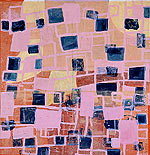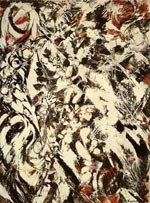Ink Has Won! Long Live Paint!
| |

| Three new painting catalogues arrived in the mail today - one on Brian Rice, British painter whose work is petroglyphic in style, Per Kirkeby, the Danish abstract landscapist, and Roberto Juarez, American painter with a new show of abstract works, a move away from earlier work which seemed more figural, using architectural elements and flowers and the occasional figure. These catalogues reminded me of how Rupert Loydell's piece, Seen 'Em Already, sent me off last week into a frenzied double-helix of speculation. We're all caught in this bind of seeing work first in reproduction like catalogues or magazines or websites and then if we're lucky seeing work in person and finding that we like it more than the photographs have suggested, or, often enough, much less. I first came to know the work of Esteban Vicente through magazine articles and liked it. Then I saw some pieces in Madrid and liked it even more. After that I tried finding more about him, even corresponding with the art historian who was working on a monograph about his career. Finally the book came out and I loved the whole story, the retrospective survey and the story of his career. I got to see a few more pieces in person in New York. I learned that in his late work he had taken to using an air gun. I didn't think too much of that until I had a chance, again in Madrid, to see a major retrospective at the Museo Reina Sophia. For the first time the work disappointed on the whole. I might have been the vacuum-like chambers of the museum, the old 18th century hospital, or poor lighting, or poor selection. Or too many paintings all at once. But it was something also about the surfaces produced by the airbrush technique. No matter how rich and sensuous Vicente was able to get the colours and surfaces, I couldn't adjust to it, couldn't like it. The surface had a thin film-like uniformity that seemed 'against paint' as I enjoyed it and for an 'auto-body' look that I liked only on autos. So I wonder if Kenneth Noland's new work will have a similar effect when I get to see it in person. Agnes Martin might have gotten into airbrushing, one supposes, but there is something in her process whereby she makes the brush she uses disappear and yet the faint textures and play of lights come somehow magically and invisibly from the hand and not from an air spray. One can't be against 'airbrush' on principle can one?? I mean wouldn't that be like be against any other method of getting the paint onto the surface - palette knives or sponges or brushes or rags or spatulas? Or combs! Rupert Loydell is the first major painter to use the comb to explore and reveal paint, to make paintings that are as different from Ink-images as possible. I suppose I am still looking for the true master of airbrush painting - but not looking too hard, given what I've seen so far. Actually, come to think of it, I did see a real master of spray paint at work in the streets of Buenos Aires. These guys were the buskers who made money by painting 'spacescape' paintings with spray paint from cans, lids and sponges to make 'planets' and galaxies and shooting stars against an impressive deep space background. They could do a painting of your choice in five to ten minutes, very slick, professional work, for about five or ten pedestrian dollars. Street paintings would look as good reproduced on paper as they do in person. This circles us back to two larger questions that Rupert raises: what is our problem with reproductions and its discontents? And what to make of a long career when we can see it all spread out before us on the coffee table or in the giant museum retrospective? I'm thinking of some analogy between the big art book and the big art show - where you now can see too many Turners all gathered together in rooms by themselves and you weary of Turner before you can even see Turner. |

| The main temptation that crystallized was to just say Admit it, the inked image has won - printed image, photographed and printed, graphic image, TV and computer screen image. So whatever paint used to be, it ain't no more. The other Thing at the very end of Rupert's piece is the sharp Opposition he Posits - between rigour = consistent body of work = serious painting Versus intuitive searching all over the place without knowing where you are going - Ayres versus Noland - in terms of archetypes. We could posit this as a Versus between Genders (we've had twenty years of that and it doesn't work, of course, but we could) taking as your model Jackson Pollock and Lee Krasner - since I recall someone making exactly that point about her work - that unlike his, which found its focus - hers is great even though she never knew where she was going and went all over the place and has no one recognizable imagistic Brand. Someone who would defend Ayres/Krasner against this kind of Consistency Fascism (sorry - for the sake of the argument and its fun) would have to defend them precisely on those grounds - that their rigor and consistency has been to explore without ordinary rigor, to be rigorous in preventing rigor mortis from settling in. Surely Ayres would 'hate' Agnes Martin's work, or Kenneth Noland's one suspects? Anyway, has not indeed INK WON? We could phone up Noland and ask him if he thinks using the airbrush has been an effort to get paint to look as cool and good as it does when it is reproduced in INK in books and magazines - and in fact we should get Collings to get this debate in print between Noland and Olitski while they are both still kicking and opinionated. Olitski of the very thick paint, glopped on and blown all around with a hair dryer and push broom. |

| Inconclusive, all that helix. Then over the weekend I saw a great painting exhibition: Colleen Randall's paintings at the Jaffe-Fried Gallery of Dartmouth College, Hanover, New Hampshire (US). I would really like to go back to see them again to see if my impressions were on the mark or just fresh caffeine in the bloodstream. They are large, or rather six are, larger than five foot square, and ten are much smaller, about 20 x 24 or 24 x 40. All in the same colour ranges - musty khaki, creamed coffee, or tree bark (oak and maple) in November light - pale, yet dark also, some white over buff - hard to describe the tones - hints of colour underneath but only one colour usually not more than two (prussian blue, earthy greens, coppery blues and greens.) so at first glance they look flat and uninteresting - 'brown' - but the gallery is small and you realize as you walk around (she knows the gallery very well and she has successfully transformed the space into a chapel or meditative space (sacred) and that is how the paintings work together as an ensemble - to create an interior light, screens or 'chambers' of dusky meditative light within the 'white cube' of the gallery. (It is actually an angled pair of rectangles, with a smaller square room with big window at one end.) So the space opens outward into the depths of the paintings. Then the eyes adjust and start to take in what is in the paintings and there is rich, rich texture of thick paint and then I think many layers of glazing over the initial thicknesses. No hand strokes, no brush strokes. You're not quite sure how the paint has been put on. It doesn't looked dripped like Pollack's, but similar, yet very different, splashed. I've decided it was thrown on, maybe after the initial heavy globs, splashed on with a sponge, so there is splatter and drip and also--most importantly - longish filaments interwoven one over another. A surface that is familiar yet not ever quite seen before. Glossy overall, but not too glossy. |

| Driving around the day after I saw the show I decided she had succeeded in capturing the tangle of the woods, the bare tree woods at this time of year on a bright November day. And the texture and light of the rock outcroppings and cuts in the hillsides you see alongside the highways - trees, tree bark, mosses, rocks, granite itself up-close, these are the 'natural sources' that suggested themselves after I had let the paintings settle into memory and imagination. And like all good painting they also stay alive as painted surfaces, as paint that is Present before you, and for painters at least they do what good paintings do - make you want to go paint again at once, make you excited all over again at what painting is about and can do, make you admire with expansive energy and maybe an expansive kind of envy what has been achieved, admire with wonder and marvel at the 'minimalist' (wrong word) use of colour and absence of form(s) to get the classic abEx overall look with at the same time wonderful depths and textures and plays of light over and under the surfaces and integuments. You immediately start placing the work with Agnes Martin, Rinehardt, Pollock (and yet for some reason I kept saying no this is not Pollock so much as it is Still and the woman who drips the white paint over black - Weir? Pat W -?? And while there is no hand or gesture in the usual sense I decided too that what you see is the wrist at work, snapping the paint down or out onto the surface from a soggy cloth or sponge. And then the look of the paint on the surface is of wetness against a pane of glass, of time stopped - splash and stretch and weavings of tangled filaments. One point of really major painting is that you struggle to put into words not just how it was done, might have been done, but how that process stays before you in the experience of the painting as it processes the light before your eyes. Major paintings, that is how they felt. Wanting more seeing, as someone wrote in the guest book, a violent yet tranquil meditative calm to them. You take home the catalogue and the next day try to remember and re-imagine, from the flat, printed INK image, the real, and the really imaginative, experience of the paintings. © Bob Garlitz 2001 |